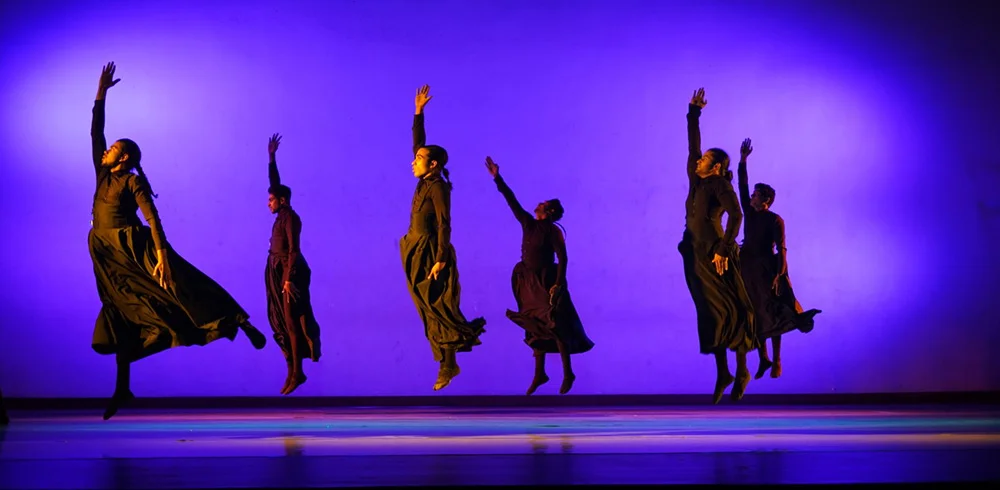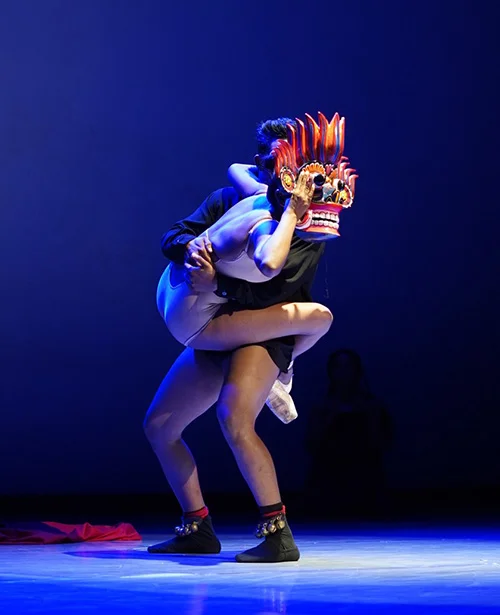Features
RIDDHI-MA:

A new Era of Dance in Sri Lanka
Kapila Palihawadana, an internationally renowned dancer and choreographer staged his new dance production, Riddhi-Ma, on 28 March 2025 at the Elphinstone theatre, which was filled with Sri Lankan theatregoers, foreign diplomats and students of dance. Kapila appeared on stage with his charismatic persona signifying the performance to be unravelled on stage. I was anxiously waiting to see nATANDA dancers. He briefly introduced the narrative and the thematic background to the production to be witnessed. According to him, Kapila has been inspired by the Sri Lankan southern traditional dance (Low Country) and the mythologies related to Riddhi Yâgaya (Riddi Ritual) and the black magic to produce a ‘contemporary ballet’.
Riddhi Yâgaya also known as Rata Yakuma is one of the elaborative exorcism rituals performed in the southern dance tradition in Sri Lanka. It is particularly performed in Matara and Bentara areas where this ritual is performed in order to curb the barrenness and the expectation of fertility for young women (Fargnoli & Seneviratne 2021). Kapila’s contemporary ballet production had intermingled both character, Riddi Bisaw (Princes Riddhi) and the story of Kalu Kumaraya (Black Prince), who possesses young women and caught in the evil gaze (yaksa disti) while cursing upon them to be ill (De Munck, 1990).
Kapila weaves a tapestry of ritual dance elements with the ballet movements to create visually stunning images on stage. Over one and a half hours of duration, Kapila’s dancers mesmerized the audience through their virtuosic bodily competencies in Western ballet, Sri Lankan dance, especially the symbolic elements of low country dance and the spontaneity of movements. It is human bodily virtuosity and the rhythmic structures, which galvanised our senses throughout the performance. From very low phases of bodily movements to high speed acceleration, Kapila managed to visualise the human body as an elevated sublimity.
Contemporary Ballet

Figure 2 – (L) Umesha Kapilarathna performs en pointe, and (R) Narmada Nekethani performs with Jeewaka Randeepa, Riddhi-Ma, at Elphinstone Theatre, Maradana, 28th March 2025. Source:
Malshan Witharana
The dance production Riddhi-Ma was choreographed in several segments accompanied by a flow of various music arrangements and sound elements within which the dance narrative was laid through. In other words, Kapila as a choreographer, overcomes the modernist deadlock in his contemporary dance work that the majority of Sri Lankan dance choreographers have very often succumbed to. These images of bodies of female dancers commensurate the narrative of women’s fate and her vulnerability in being possessed by the Black Demon and how she overcomes and emancipates from the oppression. In this sense, Kapila’s dancers have showcased their ability to use the bodies not much as an object which is trained to perform a particular tradition but to present bodily fluidity which can be transformed into any form. Kapila’s performers possess formlessness, fluid fragility through which they break and overcome their bodily regimentations.
It was such a highly sophisticated ‘contemporary ballet’ performed at a Sri Lankan theatre with utmost rigour and precision. Bodies of all male and female dancers were highly trained and refined through classical ballet and contemporary dance. In addition, they demonstrated their abilities in performing other forms of dance. Their bodies were trained to achieve skilful execution of complex ballet movements, especially key elements of traditional ballet namely, improvisation, partnering, interpretation and off-balance and the local dance repertoires. Yet, these key ballet elements are not necessarily a part of contemporary ballet training (Marttinen, 2016). However, it is important for the dance students to learn these key elements of traditional ballet and use them in the contemporary dance settings. In this sense, Kapila’s dancers have achieved such vigour and somatic precision through assiduous practice of the body to create the magic on stage.
Pas de deux
Among others, a particular dance sequence attracted my attention the most. In the traditional ballet lexicon, it is a ‘pas de deux’ which is performed by the ‘same race male and female dancers,’ which can be called ‘a duet’. As Lutts argues, ‘Many contemporary choreographers are challenging social structures and norms within ballet by messing with the structure of the pas de deux (Lutts, 2019). Pas de Deux is a dance typically done by male and female dancers. In this case, Kapila has selected a male and a female dancer whose gender hierarchies appeared to be diminished through the choreographic work. In the traditional pas de deux, the male appears as the backdrop of the female dancer or the main anchorage of the female body, where the female body is presented with the support of the male body. Kapila has consciously been able to change this hierarchical division between the traditional ballet and the contemporary dance by presenting the female dominance in the act of dance.
The sequence was choreographed around a powerful depiction of the possession of the Gara Yakâ over a young woman, whose vulnerability and the powerful resurrection from the possession was performed by two young dancers. The female dancer, a ballerina, was in a leotard and a tight while wearing a pair of pointe shoes (toe shoes). Pointe shoes help the dancers to swirl on one spot (fouettés), on the pointed toes of one leg, which is the indication of the ballet dancer’s ability to perform en pointe (The Kennedy Centre 2020).
The stunning imagery was created throughout this sequence by the female and the male dancers intertwining their flexible bodies upon each other, throwing their bodies vertically and horizontally while maintaining balance and imbalance together. The ballerina’s right leg is bent and her toes are directed towards the floor while performing the en pointe with her ankle. Throughout the sequence she holds the Gara Yakâ mask while performing with the partner.
The male dancer behind the ballerina maintains a posture while depicting low country hand gestures combining and blurring the boundaries between Sri Lankan dance and the Western ballet (see figure 3). In this sequence, the male dancer maintains the balance of the body while lifting the female dancer’s body in the air signifying some classical elements of ballet.
Haptic sense
Figure 3: Narmada Nekathani performs with the Gara Yaka mask while indicating her right leg as en pointe. Male dancer, Jeewaka Randeepa’s hand gestures signify the low country pose. Riddhi-Ma, Dance Theatre at Elphinstone Theatre, 28th March 2025. Source: Malshan Witharana.
One significant element of this contemporary ballet production is the costume design. The selection of colour palette, containing black, red and while combining with other corresponding colours and also the costumes which break the traditional rules and norms are compelling. I have discussed in a recent publication how clothes connect with the performer’s body and operate as an embodied haptic perception to connect with the spectators (Liyanage, 2025). In this production, the costumes operate in two different ways: First it signifies sculpted bodies creating an embodied, empathic experience.
Secondly, designs of costumes work as a mode of three dimensional haptic sense. Kapila gives his dancers fully covered clothing, while they generate classical ballet and Sinhalese ritual dance movements. The covered bodies create another dimension to clothing over bodies. In doing so, Kapila attempts to create sculpted bodies on stage by blurring the boundaries of gender oriented clothing and its usage in Sri Lankan dance.
Sri Lankan female body on stage, particularly in dance has been presented as an object of male desire. I have elsewhere cited that the lâsya or the feminine gestures of the dance repertoire has been the marker of the quality of dance against the tândava tradition (Liyanage, 2025). The theatregoers visit the theatre to appreciate the lâsya bodies of female dancers and if the dancer meets this threshold, then she becomes the versatile dancer. Kandyan dancers such as Vajira and Chithrasena’s dance works are explored and analysed with this lâsya and tândava criteria. Vajira for instance becomes the icon of the lâsya in the Kandyan tradition. It is not my intention here to further discuss the discourse of lâsya and tândava here.
But Kapila’s contemporary ballet overcomes this duality of male-female aesthetic categorization of lâsya and tândava which has been a historical categorization of dance bodies in Sri Lanka (Sanjeewa 2021).
Figure 4: Riddhi-Ma’s costumes creates sculpted bodies combining the performer and the audience through empathic projection. Dancers, Sithija Sithimina and Senuri Nimsara appear in Riddhi-Ma, at Elphinstone Theatre, 28th March 2025, Source, Malshan Witharana.
Conclusion
Dance imagination in the Sri Lankan creative industry exploits the female body as an object. The colonial mind set of the dance body as a histrionic, gendered, exotic and aesthetic object is still embedded in the majority of dance productions produced in the current cultural industry. Moreover, dance is still understood as a ‘language’ similar to music where the narratives are shared in symbolic movements. Yet, Kapila has shown us that dance exists beyond language or lingual structures where it creates humans to experience alternative existence and expression. In this sense, dance is intrinsically a mode of ‘being’, a kinaesthetic connection where its phenomenality operates beyond the rationality of our daily life.
At this juncture, Kapila and his dance ensemble have marked a significant milestone by eradicating the archetypical and stereotypes in Sri Lankan dance. Kapila’s intervention with Riddi Ma is way ahead of our contemporary reality of Sri Lankan dance which will undoubtedly lead to a new era of dance theatre in Sri Lanka.
References
De Munck, V. C. (1990). Choosing metaphor. A case study of Sri Lankan exorcism. Anthropos, 317-328. Fargnoli, A., & Seneviratne, D. (2021). Exploring Rata Yakuma: Weaving dance/movement therapy and a
Sri Lankan healing ritual. Creative Arts in Education and Therapy (CAET), 230-244.
Liyanage, S. 2025. “Arts and Culture in the Post-War Sri Lanka: Body as Protest in Post-Political Aragalaya (Porattam).” In Reflections on the Continuing Crises of Post-War Sri Lanka, edited by Gamini Keerawella and Amal Jayawardane, 245–78. Colombo: Institute for International Studies (IIS) Sri Lanka.
Lutts, A. (2019). Storytelling in Contemporary Ballet.
Samarasinghe, S. G. (1977). A Methodology for the Collection of the Sinhala Ritual. Asian Folklore Studies, 105-130.
Sanjeewa, W. (2021). Historical Perspective of Gender Typed Participation in the Performing Arts in Sri Lanka During the Pre-Colonial, The Colonial Era, and the Post-Colonial Eras. International Journal of Social Science And Human Research, 4(5), 989-997.
The Kennedy Centre. 2020. “Pointe Shoes Dancing on the Tips of the Toes.” Kennedy-Center.org. 2020 https://www.kennedy-center.org/education/resources-for-educators/classroom-resources/media- and-interactives/media/dance/pointe-shoes/..
Acknowledgements
The author wishes to thank Himansi Dehigama for proofreading this article.
About the author:
Saumya Liyanage (PhD) is a film and theatre actor and professor in drama and theatre, currently working at the Department of Theatre Ballet and Modern Dance, Faculty of Dance and Drama, University of the Visual and Performing Arts (UVPA), Colombo. He is the former Dean of the Faculty of Graduate Studies and is currently holding the director position of the Social Reconciliation Centre, UVPA Colombo.